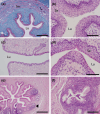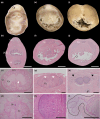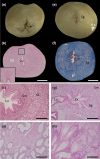Observations on the reproductive morphology of the female short-beaked echidna, Tachyglossus aculeatus
- PMID: 39325932
- PMCID: PMC11684381
- DOI: 10.1111/joa.14142
Observations on the reproductive morphology of the female short-beaked echidna, Tachyglossus aculeatus
Abstract
Although monotremes diverged from the therian mammal lineage approximately 187 million years ago, they retain various plesiomorphic and/or reptilian-like anatomical and physiological characteristics. This study examined the morphology of juvenile and adult female reproductive tracts across various stages of the presumptive oestrous cycle, collected opportunistically from cadaver specimens submitted to wildlife hospitals during the breeding season. In adult females, ovaries had a convoluted cortex with follicles protruding from the ovarian surface. While protruding antral follicles were absent from the ovaries of juvenile echidnas, histological analysis identified early developing primordial and primary follicles embedded into the ovarian cortex. The infundibulum epithelial cells of the oviducts were secretory during the follicular phase but not at other stages, the ampulla region was secretory at all stages and is likely responsible for the mucoid layer deposited around the zona pellucida, and the isthmus region of the oviduct appeared to be responsible for initial deposition of the shell coat, as in marsupials. Female echidnas have two separate uteri, which never merge and enter separately into the urogenital sinus (UGS). This study confirmed that both uteri are functional and increase in glandular activity during the luteal phase. In the juvenile uteri, the endometrium was immature with minimal, small uterine glands. A muscular cervical region at the caudal extremity of each uterus, just before the cranial region of the UGS was defined by the absence of glandular tissue in all female echidnas, including the juveniles. There was no evidence of a definitive vaginal region. A clitoris was also detected that possessed a less developed but similar structural (homologous) anatomy to the male penis; urethral ducts while present did not appear to be patent.
Keywords: cervix; monotreme; ovarian follicles; reproductive tract; uterine glands.
© 2024 The Author(s). Journal of Anatomy published by John Wiley & Sons Ltd on behalf of Anatomical Society.
Figures









Similar articles
-
Single-cell analysis comparing early-stage oocytes from fresh and slow-frozen/thawed human ovarian cortex reveals minimal impact of cryopreservation on the oocyte transcriptome.Hum Reprod. 2025 Apr 1;40(4):683-694. doi: 10.1093/humrep/deaf009. Hum Reprod. 2025. PMID: 39919251
-
The Black Book of Psychotropic Dosing and Monitoring.Psychopharmacol Bull. 2024 Jul 8;54(3):8-59. Psychopharmacol Bull. 2024. PMID: 38993656 Free PMC article. Review.
-
Impact of residual disease as a prognostic factor for survival in women with advanced epithelial ovarian cancer after primary surgery.Cochrane Database Syst Rev. 2022 Sep 26;9(9):CD015048. doi: 10.1002/14651858.CD015048.pub2. Cochrane Database Syst Rev. 2022. PMID: 36161421 Free PMC article.
-
Histology and expressions/localizations of estrogen and progesterone receptors in the reproductive tract during the natural ovarian cycle of female domestic cats ovulating spontaneously.Theriogenology. 2025 Oct 15;246:117559. doi: 10.1016/j.theriogenology.2025.117559. Epub 2025 Jun 27. Theriogenology. 2025. PMID: 40614305
-
Sexual Harassment and Prevention Training.2024 Mar 29. In: StatPearls [Internet]. Treasure Island (FL): StatPearls Publishing; 2025 Jan–. 2024 Mar 29. In: StatPearls [Internet]. Treasure Island (FL): StatPearls Publishing; 2025 Jan–. PMID: 36508513 Free Books & Documents.
References
-
- Allen NT (1982) A study of the hormonal control, chemical constituents, and functional significance of the paracloacal glands in Trichosurus vulpecula (including comparisons with other marsupials).). Perth, Australia: University of Western Australia.
-
- Augee, M.L. (2006) Echidna: extradordinary egg‐laying mammal. Collingwood, Victoria: CSIRO Publishing.
-
- Beard, L.A. , Grigg, G.C. & Augee, M.L. (1992) Reproduction by echidnas in a cold climate. In: Augee, M.L. (Ed.) Platypus and echidnas. Mosman, New South Wales, Australia: The Royal Zoological Society of NSW, Sydney, pp. 93–100.
-
- Buchtova, M. , Handrigan, G.R. , Tucker, A.S. , Lozanoff, S. , Town, L. , Fu, K. et al. (2008) Initiation and patterning of the snake dentition are dependent on Sonic hedgehog signaling. Developmental Biology, 319, 132–145. - PubMed
-
- Dutton‐Regester, K. , Keeley, T. , Fenelon, J.C. , Roser, A. , Meer, H. , Hill, A. et al. (2021) Plasma progesterone secretion during gestation of the captive short‐beaked echidna. Reproduction, 162, 267–275. - PubMed
Publication types
MeSH terms
Grants and funding
LinkOut - more resources
Full Text Sources

